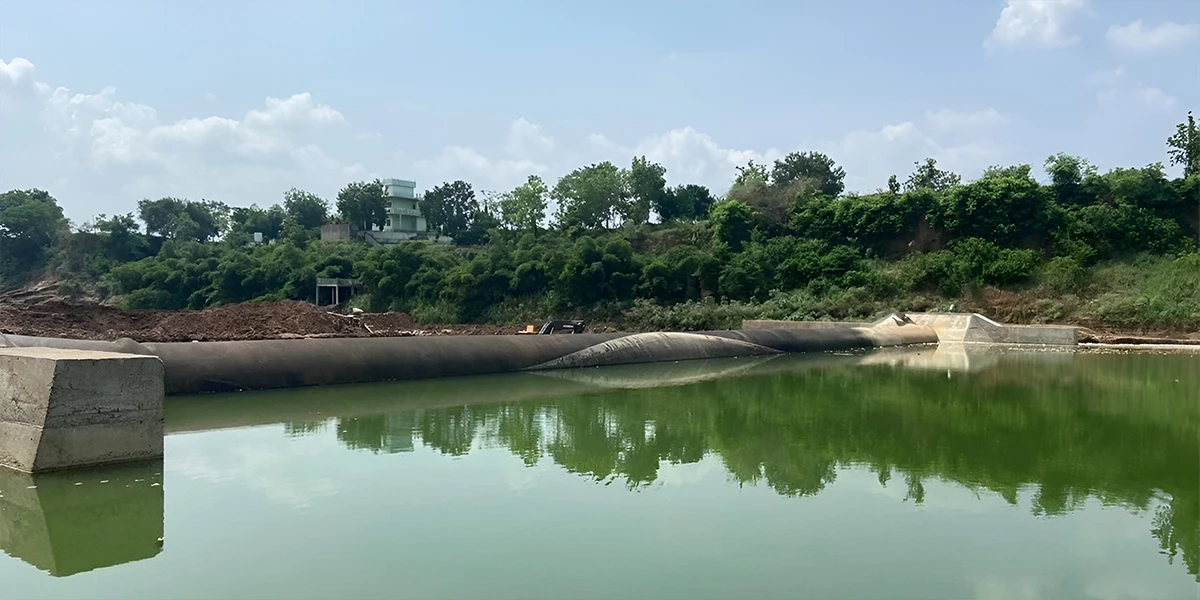

Innovative solutions are reshaping our interactions with our most valuable natural resource because the world confronts steadily increasing difficulties regarding water conservation, sustainable water management, and effective flood control. The inflatable rubber dam solution is a game-changer and has caused a wave of popularity both in India and worldwide. Moderate rubber dams operate as an environmentally friendly, flexible water control system that adapts to different environments.
An inflatable rubber dam consists of reinforced rubberized fabric formed into a cylindrical shape, which becomes operational by being inflated with water or air across rivers, drainage channels, and streams. The operation of these dams depends on adding liquid water or air pressure to achieve water blockage, then deflation restores their original shape before use. The elastic water management system gives operators the ability to store and divert water and regulate floods through its flexible design.
The main advantage of rubber dams compared to traditional structures is their light weight design along with budget-friendly operation characteristics and the quickness of installation and operations. Rubber dams continue to grow in use within urban stormwater management along with their applications in irrigation systems and river beautification and hydropower operations and recreational water construction.
Among rubber dam types, there exists a wide range that matches various geographical regions and water characteristics. The most common types include:
The air-inflated rubber dams obtain air inflation for operations that need regular adjustment. Rubber dams enable quick changes between inflation states and deflation states.
The usage of water as the inflation medium in rubber dams produces heavy structures which maintain stability under strong water pressure forces.
Current rubber dam installations employ both water and air inflation techniques for enhancing system performance and extending operating life expectancy.
Yooil Envirotech operates as a worldwide water management leader that designs installations of all rubber dam types to generate solutions that precisely address specific site difficulties in India.
India, with its complex water distribution systems and seasonal monsoons, faces both floods and droughts—often in the same region. Traditional methods of water retention and control have their limitations. Enter Yooil Envirotech, a pioneer in sustainable water infrastructure, introducing rubber dam construction that is cost-efficient, eco-friendly, and adaptable.
One of the most revolutionary implementations by Yooil Envirotech includes the longest rubber dam in India, installed to manage river flow for both agricultural and urban use. Such projects have not only improved local irrigation systems but have also minimized flood-related damages and revitalized nearby ecosystems.
There are numerous rubber dam advantages that make them a preferred solution for modern water management:
Compared to traditional concrete dams, rubber dams require less civil construction. This leads to a significant reduction in project costs and faster deployment.
Their ability to inflate and deflate means they can adapt to changing water levels, reducing flood risks and allowing seasonal usage control.
Rubber dams have a low environmental footprint. They do not obstruct fish migration or alter the ecosystem permanently, making them ideal for environmentally sensitive areas.
In urban environments, rubber dams help maintain a constant water level in rivers and canals, enhancing the aesthetic appeal of the cityscape and supporting recreational use.
Constructed from high-strength rubber and reinforced fabric, these dams are resistant to UV radiation, chemicals, and wear and tear, ensuring long-term performance.
The versatility of rubber dam water applications is vast. Some prominent use-cases include:
Irrigation Control: Rubber dams enable water storage during monsoons, which can be later used for irrigation during dry periods.
Flood Management: During periods of heavy rainfall, the dam can be deflated to allow unimpeded flow, preventing waterlogging and damage.
Hydroelectric Projects: Small-scale hydropower units can be integrated with rubber dam setups, providing sustainable energy to nearby areas.
Urban Riverfront Development: Controlled water levels allow for the creation of urban waterfronts, promoting tourism and recreation.
Yooil Envirotech is at the forefront of implementing these technologies in India, working in close partnership with local governments and private developers.
With global expertise and a strong local presence, Yooil Envirotech has been instrumental in setting new benchmarks for rubber dam construction in India. From design to execution, their projects reflect technical brilliance, environmental responsibility, and innovative engineering.
Each rubber dam project by Yooil undergoes a detailed feasibility analysis, considering hydrological data, sediment load, climate conditions, and community impact. The result is a tailor-made, resilient, and efficient water control system that stands the test of time.
Their projects, including the longest rubber dam in India, serve as testaments to how modern engineering can harmonize with nature to serve communities better.
As India continues to tackle complex water challenges, innovative solutions like inflatable rubber dam is leading the way. With their adaptability, sustainability, and cost-effectiveness, they represent the future of water infrastructure.
Backed by global technology and local expertise, Yooil Envirotech is championing this transformation, redefining how we manage water, mitigate floods, and secure agricultural prosperity. Whether you're planning an irrigation project, an urban beautification drive, or a flood control measure, investing in a rubber dam system is not just smart—it's sustainable.
Ready to embrace the future of water management? Connect with Yooil Envirotech today and discover the power of inflatable rubber dams.
Innovative solutions are reshaping our interactions with our most valuable natural resource because the world confronts steadily increasing difficulties regarding water conservation, sustainable water management, and effective flood control. The inflatable rubber dam solution has caused a wave of popularity both in India and worldwide. Moderate rubber dams operate as an environmentally friendly, flexible water control system that adapts to different environments.
An inflatable rubber dam consists of reinforced rubberized fabric formed into a cylindrical shape, which becomes operational by being inflated with water or air across rivers, drainage channels, and streams. The operation of these dams depends on adding liquid water or air pressure to achieve water blockage, then deflation restores their original shape before use. The elastic water management system gives operators the ability to store and divert water and regulate floods through its flexible design.
The main advantage of rubber dams compared to traditional structures is their light weight design along with budget-friendly operation characteristics and the quickness of installation and operations. Rubber dams continue to grow in use within urban stormwater management along with their applications in irrigation systems and river beautification and hydropower operations and recreational water construction.
Among rubber dam types, there exists a wide range that matches various geographical regions and water characteristics. The most common types include:
The air-inflated rubber dams obtain air inflation for operations that need regular adjustment. Rubber dams enable quick changes between inflation states and deflation states.
The usage of water as the inflation medium in rubber dams produces heavy structures which maintain stability under strong water pressure forces.
Current rubber dam installations employ both water and air inflation techniques for enhancing system performance and extending operating life expectancy.
Yooil Envirotech operates as a worldwide water management leader that designs installations of all rubber dam types to generate solutions that precisely address specific site difficulties in India.
India, with its complex water distribution systems and seasonal monsoons, faces both floods and droughts—often in the same region. Traditional methods of water retention and control have their limitations. Enter Yooil Envirotech, a pioneer in sustainable water infrastructure, introducing rubber dam construction that is cost-efficient, eco-friendly, and adaptable.
One of the most revolutionary implementations by Yooil Envirotech includes the longest rubber dam in India, installed to manage river flow for both agricultural and urban use. Such projects have not only improved local irrigation systems but have also minimized flood-related damages and revitalized nearby ecosystems.
There are numerous rubber dam advantages that make them a preferred solution for modern water management:
Compared to traditional concrete dams, rubber dams require less civil construction. This leads to a significant reduction in project costs and faster deployment.
Their ability to inflate and deflate means they can adapt to changing water levels, reducing flood risks and allowing seasonal usage control.
Rubber dams have a low environmental footprint. They do not obstruct fish migration or alter the ecosystem permanently, making them ideal for environmentally sensitive areas.
In urban environments, rubber dams help maintain a constant water level in rivers and canals, enhancing the aesthetic appeal of the cityscape and supporting recreational use.
Constructed from high-strength rubber and reinforced fabric, these dams are resistant to UV radiation, chemicals, and wear and tear, ensuring long-term performance.
The versatility of rubber dam water applications is vast. Some prominent use-cases include:
Yooil Envirotech is at the forefront of implementing these technologies in India, working in close partnership with local governments and private developers.
With global expertise and a strong local presence, Yooil Envirotech has been instrumental in setting new benchmarks for rubber dam construction in India. From design to execution, their projects reflect technical brilliance, environmental responsibility, and innovative engineering.
Each rubber dam project by Yooil undergoes a detailed feasibility analysis, considering hydrological data, sediment load, climate conditions, and community impact. The result is a tailor-made, resilient, and efficient water control system that stands the test of time.
Their projects, including the longest rubber dam in India, serve as testaments to how modern engineering can harmonize with nature to serve communities better.
As India continues to tackle complex water challenges, innovative solutions like inflatable rubber dam is leading the way. With their adaptability, sustainability, and cost-effectiveness, they represent the future of water infrastructure.
Backed by global technology and local expertise, Yooil Envirotech is championing this transformation, redefining how we manage water, mitigate floods, and secure agricultural prosperity. Whether you're planning an irrigation project, an urban beautification drive, or a flood control measure, investing in a rubber dam system is not just smart—it's sustainable.
Ready to embrace the future of water management? Connect with Yooil Envirotech today and discover the power of inflatable rubber dams.
